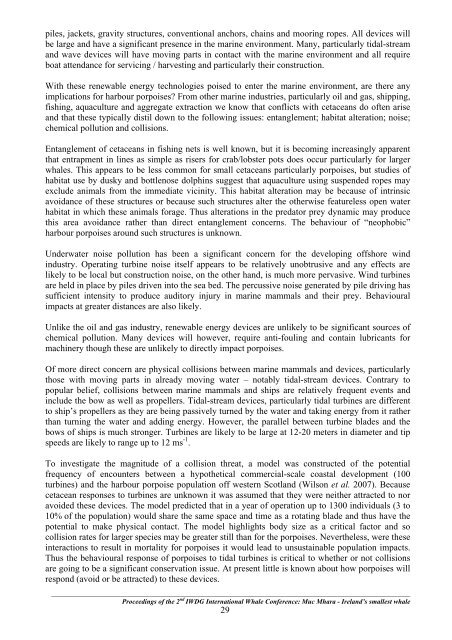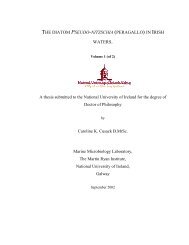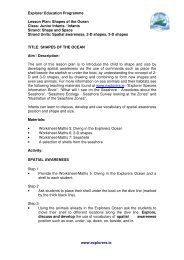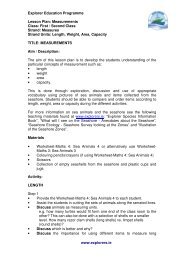Muc Mhara Ireland's Smallest Whale - Marine Institute Open Access ...
Muc Mhara Ireland's Smallest Whale - Marine Institute Open Access ...
Muc Mhara Ireland's Smallest Whale - Marine Institute Open Access ...
Create successful ePaper yourself
Turn your PDF publications into a flip-book with our unique Google optimized e-Paper software.
piles, jackets, gravity structures, conventional anchors, chains and mooring ropes. All devices will<br />
be large and have a significant presence in the marine environment. Many, particularly tidal-stream<br />
and wave devices will have moving parts in contact with the marine environment and all require<br />
boat attendance for servicing / harvesting and particularly their construction.<br />
With these renewable energy technologies poised to enter the marine environment, are there any<br />
implications for harbour porpoises? From other marine industries, particularly oil and gas, shipping,<br />
fishing, aquaculture and aggregate extraction we know that conflicts with cetaceans do often arise<br />
and that these typically distil down to the following issues: entanglement; habitat alteration; noise;<br />
chemical pollution and collisions.<br />
Entanglement of cetaceans in fishing nets is well known, but it is becoming increasingly apparent<br />
that entrapment in lines as simple as risers for crab/lobster pots does occur particularly for larger<br />
whales. This appears to be less common for small cetaceans particularly porpoises, but studies of<br />
habitat use by dusky and bottlenose dolphins suggest that aquaculture using suspended ropes may<br />
exclude animals from the immediate vicinity. This habitat alteration may be because of intrinsic<br />
avoidance of these structures or because such structures alter the otherwise featureless open water<br />
habitat in which these animals forage. Thus alterations in the predator prey dynamic may produce<br />
this area avoidance rather than direct entanglement concerns. The behaviour of “neophobic”<br />
harbour porpoises around such structures is unknown.<br />
Underwater noise pollution has been a significant concern for the developing offshore wind<br />
industry. Operating turbine noise itself appears to be relatively unobtrusive and any effects are<br />
likely to be local but construction noise, on the other hand, is much more pervasive. Wind turbines<br />
are held in place by piles driven into the sea bed. The percussive noise generated by pile driving has<br />
sufficient intensity to produce auditory injury in marine mammals and their prey. Behavioural<br />
impacts at greater distances are also likely.<br />
Unlike the oil and gas industry, renewable energy devices are unlikely to be significant sources of<br />
chemical pollution. Many devices will however, require anti-fouling and contain lubricants for<br />
machinery though these are unlikely to directly impact porpoises.<br />
Of more direct concern are physical collisions between marine mammals and devices, particularly<br />
those with moving parts in already moving water – notably tidal-stream devices. Contrary to<br />
popular belief, collisions between marine mammals and ships are relatively frequent events and<br />
include the bow as well as propellers. Tidal-stream devices, particularly tidal turbines are different<br />
to ship’s propellers as they are being passively turned by the water and taking energy from it rather<br />
than turning the water and adding energy. However, the parallel between turbine blades and the<br />
bows of ships is much stronger. Turbines are likely to be large at 12-20 meters in diameter and tip<br />
speeds are likely to range up to 12 ms -1 .<br />
To investigate the magnitude of a collision threat, a model was constructed of the potential<br />
frequency of encounters between a hypothetical commercial-scale coastal development (100<br />
turbines) and the harbour porpoise population off western Scotland (Wilson et al. 2007). Because<br />
cetacean responses to turbines are unknown it was assumed that they were neither attracted to nor<br />
avoided these devices. The model predicted that in a year of operation up to 1300 individuals (3 to<br />
10% of the population) would share the same space and time as a rotating blade and thus have the<br />
potential to make physical contact. The model highlights body size as a critical factor and so<br />
collision rates for larger species may be greater still than for the porpoises. Nevertheless, were these<br />
interactions to result in mortality for porpoises it would lead to unsustainable population impacts.<br />
Thus the behavioural response of porpoises to tidal turbines is critical to whether or not collisions<br />
are going to be a significant conservation issue. At present little is known about how porpoises will<br />
respond (avoid or be attracted) to these devices.<br />
_________________________________________________________________________________________________________<br />
Proceedings of the 2 nd IWDG International <strong>Whale</strong> Conference: <strong>Muc</strong> <strong>Mhara</strong> - Ireland’s smallest whale<br />
29





